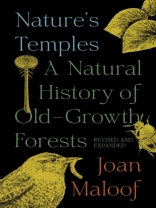An impassioned case for the importance of ancient forests and their preservation
Standing in an old-growth forest, you can instinctively sense the ways it is different from forests shaped by humans. These ancient, undisturbed ecosystems are increasingly rare and largely misunderstood. Nature’s Temples explores the science and alchemy of old-growth forests and makes a compelling case for their protection.
Many foresters are proponents of forest management, while ecologists and conservation biologists believe that the healthiest forests are those we leave alone. Joan Maloof brings together the scientific data we have about old-growth forests, drawing on diverse fields of study to explain the ecological differences among forests of various ages. She describes the life forms and relationships that make old-growth forests unique—from salamanders and micro-snails to plants that communicate through fungi—and reveals why human attempts to manage forests can never replicate nature’s sublime handiwork. This revised and expanded edition also sheds new light on the special role forests play in removing carbon from the atmosphere and shares what we know about the interplay between wildfires and ancient forests.
With drawings by Andrew Joslin that illustrate scientific concepts and capture the remarkable beauty of ancient trees, Nature’s Temples invites you to discover the power of these fragile realms that are so inextricably connected to our planet, our fellow species, and our spirits.
Circa l’autore
Joan Maloof, Ph D, is founder and director of the Old-Growth Forest Network, a national organization that works to save threatened forests, and professor emerita of biological sciences at Salisbury University. Her books include
Treepedia (Princeton) and
Teaching the Trees.












